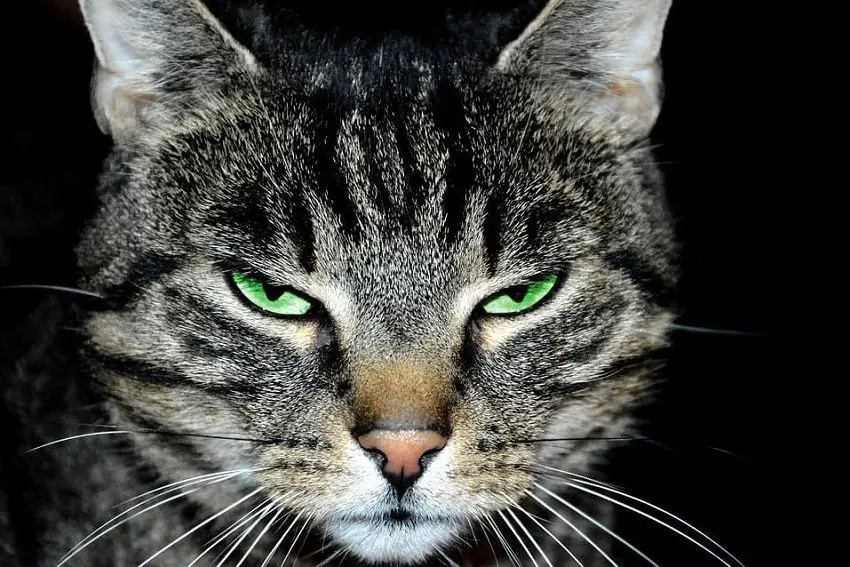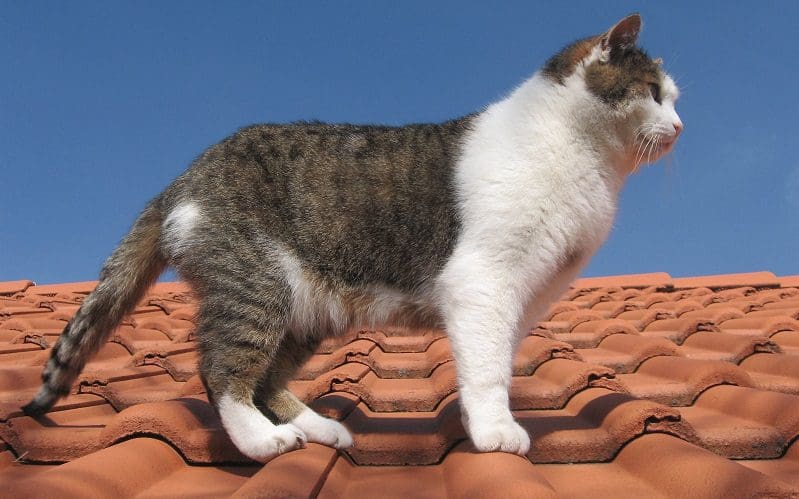Last Updated: 4 months ago
A lot of people are wondering about cat pheromones when someone is looking to get a female cat.
Most people are scared that if they get a female cat, there will be many male cats on my rooftop.
I don’t know about you, but the visual image I get of that happening is pretty funny!
In all seriousness, pheromones are no joke, and they can cause male cats to do some serious prowling.
Let’s talk a bit about what they are and just how far can a male cat smell a female in heat!
What are pheromones?

Pheromone is “a chemical an animal produces that changes the behavior of another animal of the same species.”
The article goes on to say that pheromones are not only linked to sexual arousal; they also trigger behaviors like alarm, respect of territory, and bonding between mother and baby.
Let’s talk a bit about how they apply to cats.
How do pheromones apply to cats?
Cats have an incredible sense of smell, and pheromones are like their road map.
As mentioned above, pheromones don’t just say, “Hey, I’m in heat; come and get me!” They actually play a few important roles.
Let’s take a closer look, shall we?
1. Mating Signals
Since you’re here to learn mostly about the purpose of pheromones, it’s a good place to start.
Females put out certain chemicals when they’re in heat. This acts as a signal to male cats that she’s ready to mate.
If she’s successful in getting pregnant, she stops sending out signals. Likewise, if the cat is spayed, she will never send out mating signals again.
2. Name, Rank, And Serial Number
Okay, so your cat’s pheromones don’t exactly provide all of that information, but both males and females spray pheromones that tell other cats their location and gender.
Male cats’ “spray” also tells other males where they rank in the kitty hierarchy.
We have a male feral in our area that apparently ranks very high because all the other boys leave during mating season to give him free reign.
3. A Road map for kittens
The pheromones in a mama cat’s milk not only help calm kittens but also provide a road map to help them find her if they get separated.
Products like Feliway pheromone diffuser mimic this chemical, which in turn may help calm a crazy kitty.
As you can see, pheromones are important to all aspects of your cat’s life. They’re especially vital to outdoor or feral cats!
Now, let’s discuss what happens when your cat is in heat.
Facts about Cats in Heat

Female cats reach maturity around 6 months (varies from cat to cat), and at this point, their “heat” or estrus cycles begin.
During each breeding season (which varies according to geography and environment—an indoor cat’s breeding cycle could be year-round!), a cat goes into estrus several times.
They are “in heat” for 1–7 days, and if mating doesn’t occur, they will go “out of heat” for 1-2 weeks before the cycle begins again.
During this time, male cats as young as 4 months old will likely show up at your house and try to get in with the female.
As for how far they’ll travel, there isn’t an exact number of miles, but some say cats will come from as far as 1-2 miles away.
How can you avoid male cats on your roof?

The only surefire way to avoid male cats coming around during a female cat’s heat cycle is to have a vet perform a spay surgery.
During my mother’s childhood, they had a cat who always managed to sneak out and get pregnant while she was in heat.
Keep in mind that this was long before spaying was really encouraged. Over the course of the cat’s life, she had hundreds of kittens that my grandparents had to find homes for.
That seems like an awful lot of work! Keeping a cat away from other cats is not easy, and the only certain way to avoid pregnancy is surgical sterilization.
Wrap-Up
Now that you have some background on how pheromones affect behavior in cats, do some of the things they do make a little more sense?
If you have an unaltered female cat, do you notice neighborhood tomcats coming around when she’s in heat?
What ways have you found to deter them? We’d love to hear about it!
Resources:


Dr. Linda Simon MVB MRCVS is a locum veterinary surgeon who has worked in London for the past 8 years. She graduated top of her class in small animal medicine from UCD, Dublin. She is currently a member of the Royal College of Veterinary Surgeons. Linda is the resident vet for Woman magazine and a frequent contributor to People’s Friend Magazine, the Dogzone website, Vet Help Direct and Wag! Linda also writes content for the CVS veterinary group, Vetwriter and a number of other establishments.
